Alert! The new star we’ve been talking about is about to explode. Experts estimate the time for the nova eruption is close to now. Get ready to see a new star in the night sky. According to NASA, it’s a rare “once-in-a-lifetime” event. Bob Berman has the details.
The 2024 Nova Event
If you’ve been following our newsletter, you know this year has already brought a rich bounty of celestial spectacles. Stunning pink-purple auroras. A total solar eclipse. All could be seen without the use of telescopes.
Are there any traditional sky spectacles left in the folder? It certainly seems like it. Many online, print, and TV media spent the past month headlining an expected “new star” that could explode into naked-eye visibility at any time.
When we hear that a “Nova Will Blaze In the Sky,” it definitely sounds like something we shouldn’t miss.
T Coronae Borelais (T CrB)
The impending “new star in the sky” will emerge from a binary star system (i.e., two stars or Suns that orbit each other). Officially named “T Coronae Borealis” or T CrB (pronounced “tee-core-bore”), the media is also calling it “Blaze Star.” Why? It will soon undergo a violent outburst and blaze in the night skies as a new star within the constellation Corona Borealis.
This event is called a “nova explosion.” According to NASA’s nova expert Rebekah Hounsell, “It’s a once-in-a-lifetime event that will create a lot of new astronomers out there, giving young people a cosmic event they can observe for themselves,
What is a Nova Explosion?
Don’t get “nova” confused with “supernova;” the latter happens when a star explodes and is destroyed. Rather, “nova” means “new star” in Latin.
A nova explosion happens when the two stars in the binary system—two oddball suns—get close together. One star is a tiny, compressed-like-steel “white dwarf” the size of Earth. The white dwarf orbits around a second star, a red supergiant. The white dwarf is small and hot with incredibly powerful gravity.
Material, mostly hydrogen gas, flows off the red giant’s surface and has been steadily pulled by the tiny white star’s supergravity. It has also been steadily accumulating on the dwarf’s surface, held tightly by its hyper-strong gravity, more than 300,000 times greater than that of our own planet.
Every 80 years, enough material accumulates to ignite in a frenzied H-bomb-like explosion, making the pair of stars more than a hundred times brighter than before. Suddenly, our unaided naked eyes see a moderately bright star there where nothing was previously visible.
The end result is a sudden flash and the appearance of a very bright “new star” in the night sky!
When Will the 2024 Nova Explosion Happen?
We’ll see the nova explosion of the “Blaze Star” this summer. It could happen any day now. Keep our ears open for the news on the media or alerts from SpaceWeather.com. Once the explosion happens, this blazing star will only be visible for a few days.
Dr. Elizabeth Hays, chief of the Astroparticle Physics Laboratory at NASA Goddard, says, “Typically, nova events are so faint and far away … This one will be really close!”
After the explosion, the plasma will burn off, and the star will fade. Then, the cycle will start all over again and repeat. Often, the cycle can be hundreds or thousands of years long. For “T Coronae Borealis,” the event should reoccur, on average, every 80 years. In other words, it won’t occur for most of us in our lifetime.
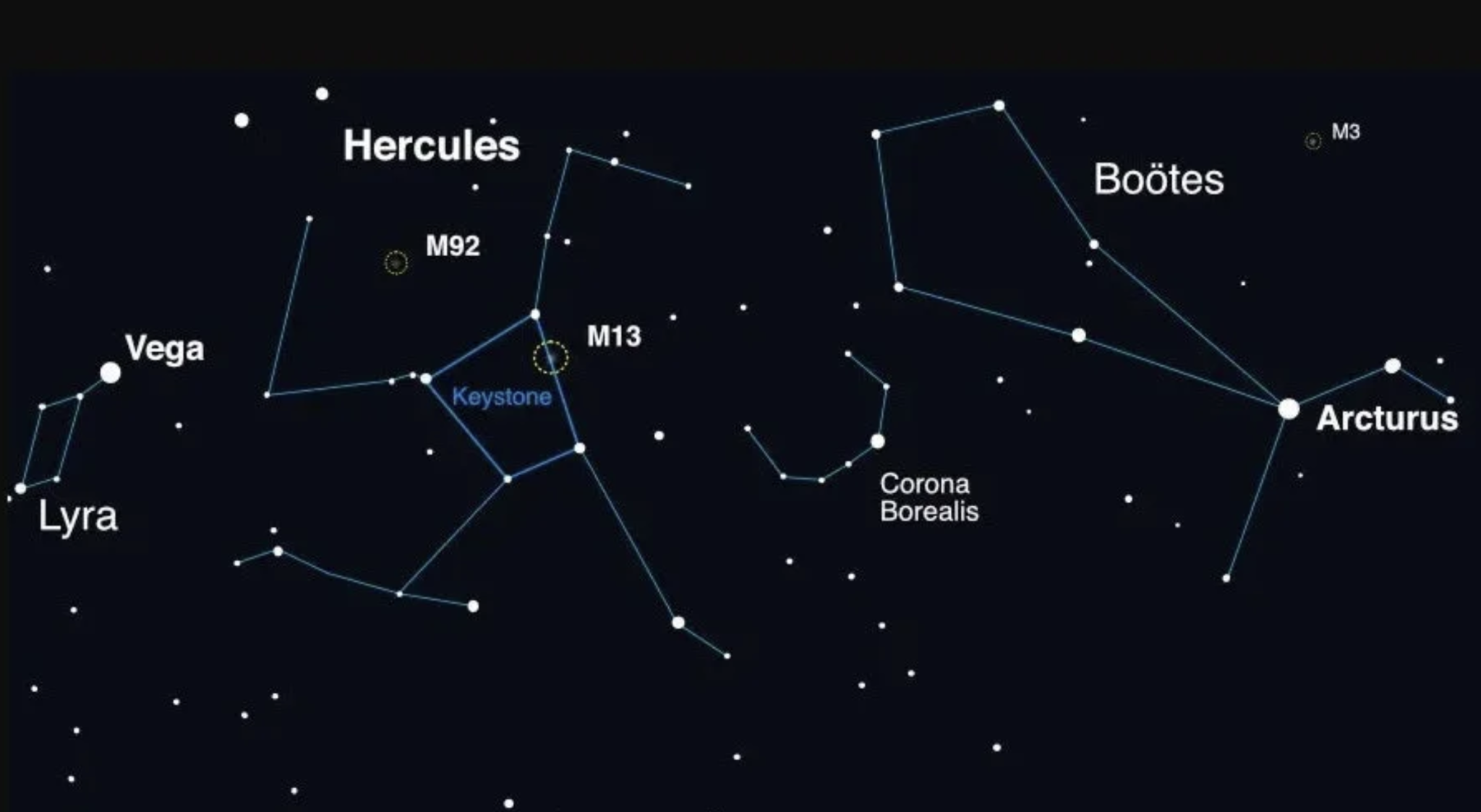
How to Find the New Star
First, go outside tonight and see what Corona Borealis normally looks like. Then, when the nova explodes, you can tell the difference.
Of course, you won’t have me, your friendly astronomer, to take you outside and declare, “There it is!” So how on Earth are you supposed to find this thing?
The other night, leading an outdoor class, I tried a promising original method for making the nova’s predicted position an easy-peasy contest, and it worked. The method left everyone seemingly comfortable, and they could easily locate it without needing the slightest media announcement or star chart. So how about it? Worth five minutes of your time right now?
It’s a three-step process:
- First, find Arcturus. If you’re a celestial newbie, this star is on your “instant ID” list. It’s the brightest summertime star and directly overhead during the night for those of us in the Northern Hemisphere. It’s one of the highest-up stars between nightfall and 10:30 PM. You can easily check Arcturus’ identity because the Big Dipper is also high up, and its handle “arcs to Arcturus,” one of the first astro-cliches every beginner repeatedly hears. Just look high up, and there’s Arcturus. Its brilliance and distinctive orange pastel hue are a giveaway. Discover the mysteries of Arcturus.
- Then, look for your second signpost—Vega. It’s the only other brilliant star right now and the only one that matches Arcturus’ brightness. This one is diamond-like because it boasts a pastel blue-white and has a famous name: Vega. (Say “VEE-ga” to yourself as a pronunciation reminder, one we’ve already announced a few hundred times since the last Full Moon.) The nova will happen one-third of the way between Arcturus and Vega. Now let’s make this so ironclad-solid: you’ll be your neighborhood’s nova authority, no joke. Learn facts and folklore about beautiful Vega.
- The Corona Borealis constellation is between Arcturus and Vega. Look one-third of the way along a straight line from Arcturus to Vega, and you’ll see a bright but not brilliant star. It’s not in the same zero-magnitude class as Arcturus and Vega. But it’s the only other fairly bright overhead star. This is Gemma, easy to remember because it represents the “gem” in the crown, which is our constellation Corona Borealis. Its stars form a reversed “C” shape, and you’re supposed to visualize a delicately curved princess’s tiara, the Northern Crown constellation. The gem star Gemma was called Alphecca by the ancient Arabs and is the brightest member of the backwards-C of faintish stars where the nova will happen.
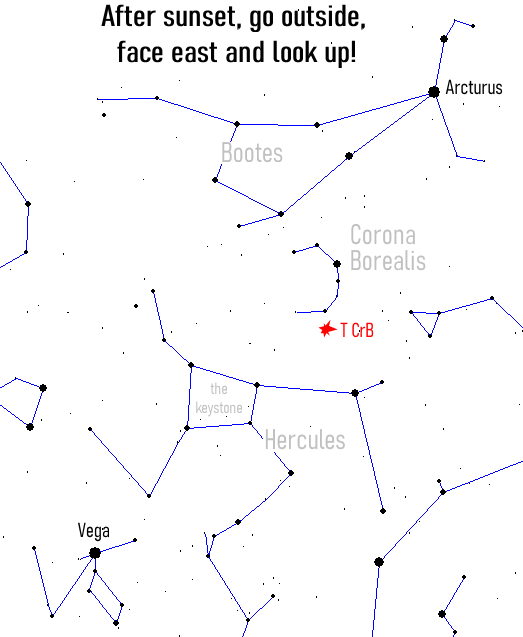
Where Will the Nova Explode?
Count the third faint star to the left of Gemma. That little star named Epsilon is exactly where you want to glance each night from now on, whenever you’re already out under clear skies, taking an evening stroll. The important thing? That’s where the nova will explode—next to that faintish star, which is three stars left of Gemma, which is the only bright star between Arcturus and Vega. Now you know exactly where the nova will go, Kaplooie.
The nova should be brighter than Gemma, the constellation’s main Alpha star. So, bottom line, sometime this year, there’ll be two decently bright stars close together, Gemma and the Nova, with both sitting in that spot one-third of the way between Arcturus and Vega. It’ll be eye-catching if you know where to look. And now you do know where to look.
How Bright Will the Nova Be?
The new star will certainly be bright, but it won’t be the brightest object in the sky (other than the Sun and Moon), as many media sources say. The wrinkle in this nova teaser is that at maximum light, astronomers say it won’t get any brighter than 2nd magnitude, so at least four dozen summer stars will outshine it. So that’s not nothing, but it’s not a blinding light.
Certainly, its brightness will beat out Gemma, who will no longer be the alpha-looking star of Corona Borealis. It will roughly match Polaris, the North Star, and those of Orion’s belt.
More Tips and Tricks
This exact same process created a nova in 1866 and then not again until 1946, giving these flare-ups a roughly 80-year period. Before each explosion, the star’s already-dim telescope appearance diminishes for about a year, so that’s our tip-off—since that’s what’s been happening lately.
The trick for easily seeing this explosion for yourself is simply to follow the directions above and check it out every clear night until you can comfortably and instantly find the right spot in Corona Borealis. When it’s comfortable to glance there effortlessly, keep checking on it whenever you’re out. It’s no big deal.
Also, find the Corona Borealis using the Interactive Night Sky Map from TimeandDate.
Weeks or even months may pass. But one night, wham-O. Then you can rush inside, find that page on your desk where you’ve checked off “aurora” and “total solar eclipse,” and put a big X next to: “Nova”!
Will you be out looking for the Nova? We will be!
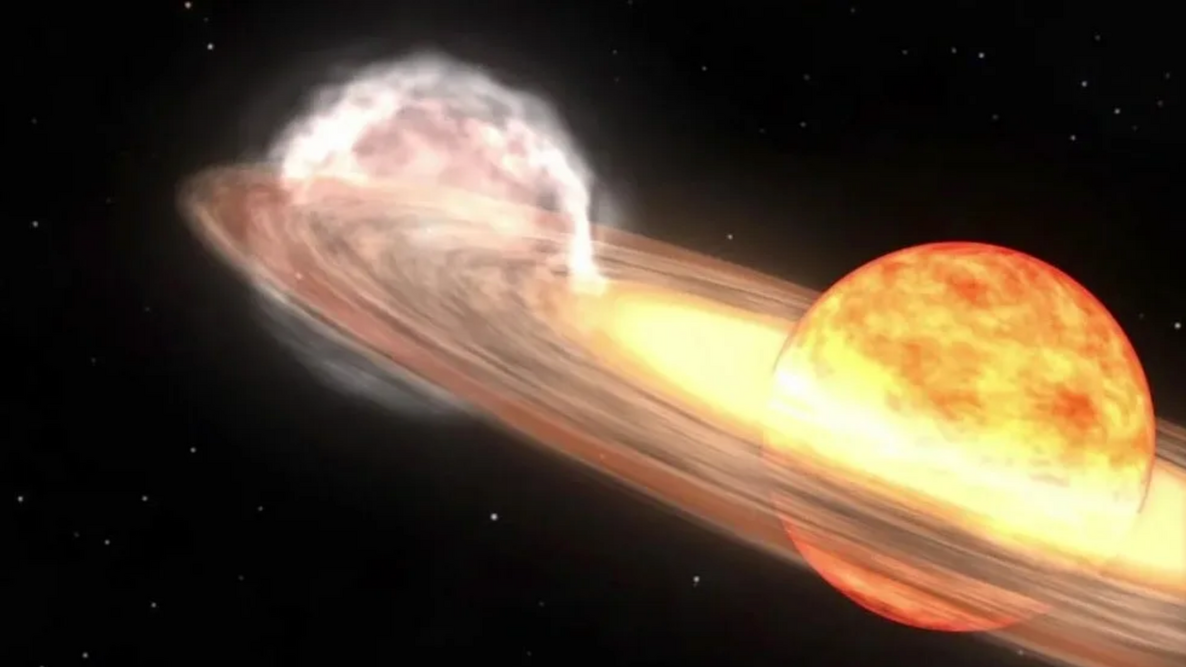




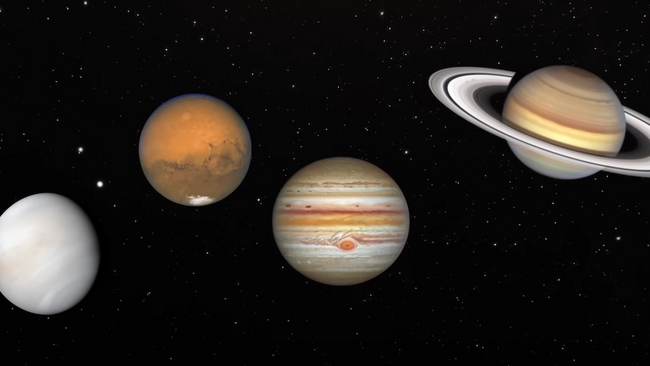



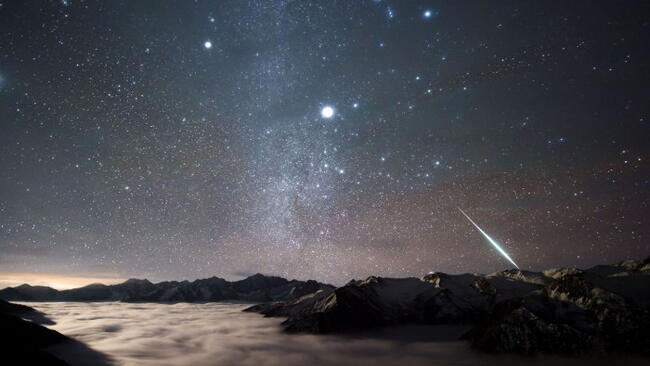
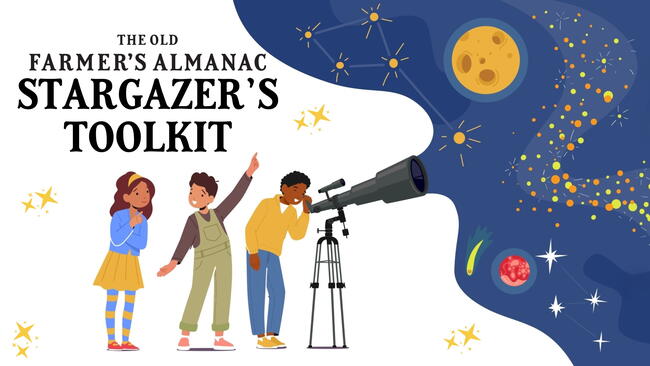

Comments